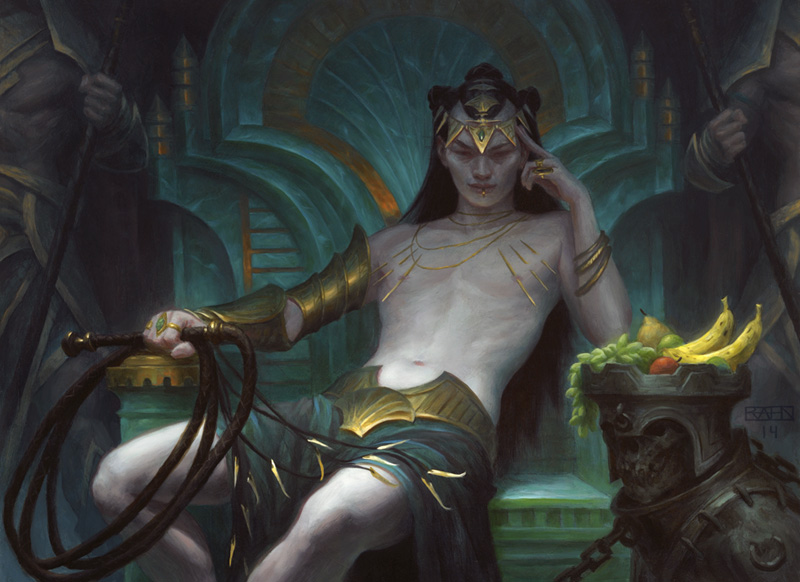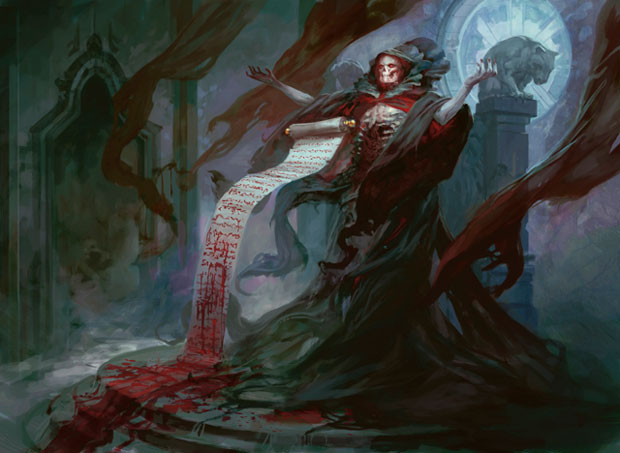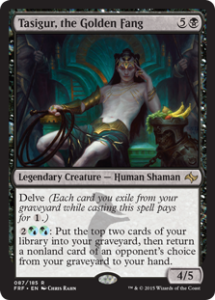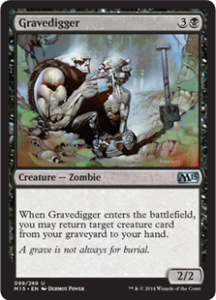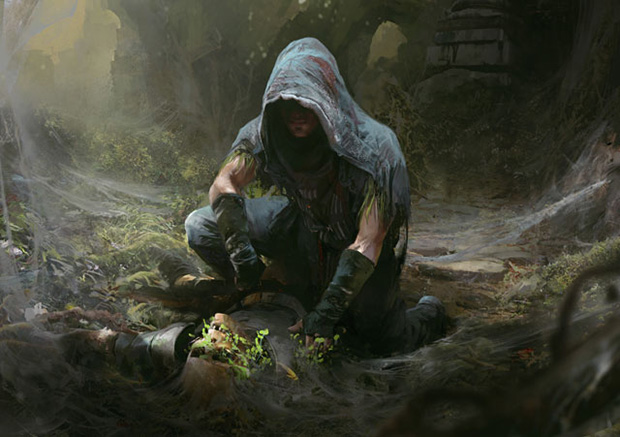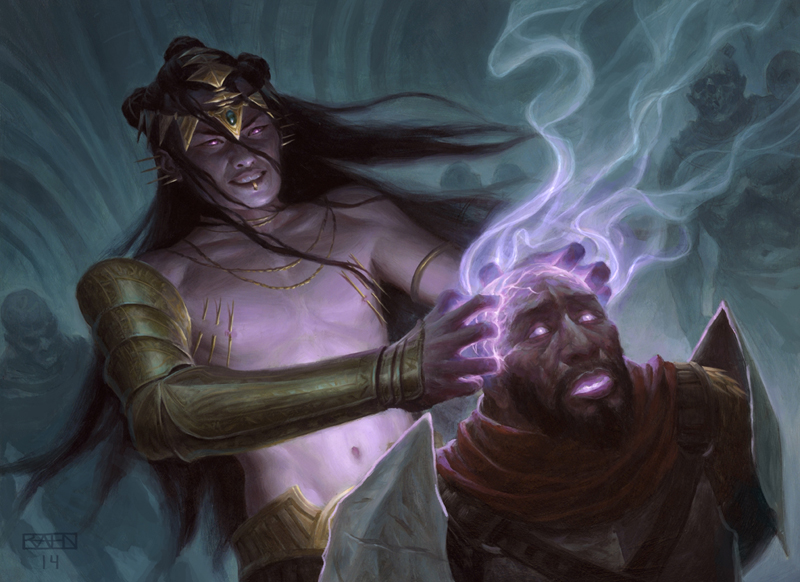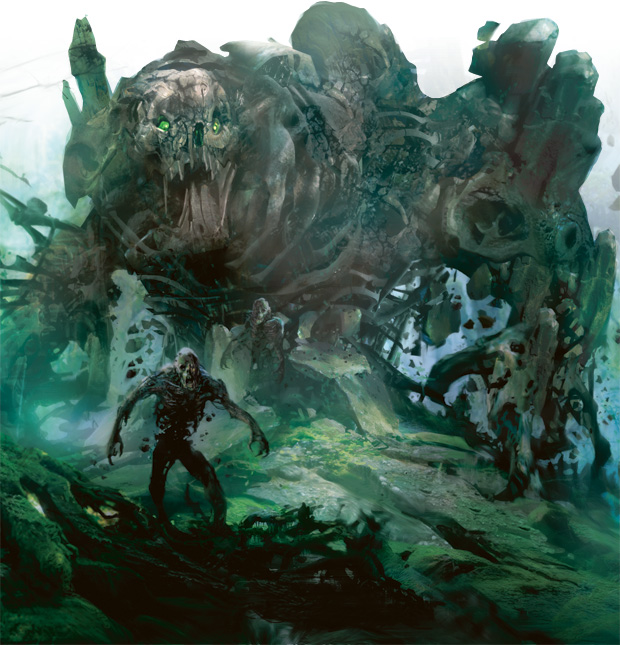Hi! I’m Harry Huberty, Geekly Inc.’s new resident Magic fanatic. Elsewhere on this fine site, I’ll also be writing on the aesthetics of Magic and other fantasy art with Christina Ladd. In this series, I’m going to focus on playing Magic, for the more casual crowd.
So this column is for you and your gaming group. I figure that you have lots of options for Game Night, and I think Magic should be one of them. To that end, I’ll focus on casual formats, especially ones that take a little less investment and a little less encyclopedic knowledge of Magic cards. I’ll assume you know the basics of playing, but aren’t completely obsessed. You can leave the obsession to me! Or, get obsessed with me, and we’ll see where that takes us. I love Magic, and you should too.
Today’s project: a Commander deck designed around Tasigur, the Golden Fang. (Or, how to bake a Sultai cheesecake.)
If you’ve never heard of Commander, you’re missing out. Specifically, you’re missing out on one of the best casual formats ever created for any game. Commander gives you a great format for identifying with a card and exploring the kinds of playstyles that card recommends for you. Even better, the games often lead to the sorts of epic moments that make Game Night such great fun.
So, quickly, the rules:
- Each player needs a Commander deck. Good Commander games have three, four, or five players.
- Each Commander deck is exactly 100 cards. There are a few deckbuilding restrictions:
- You select one legendary creature card and designate it as your deck’s Commander.
- Your deck has 99 other cards in it. Only one copy of each card is allowed. (Multiple basic lands—Plains, Island, Swamp, Mountain, and Forest—are okay. But that’s the only exception.)
- Except for a small banned list, you can use any card ever printed.
- Your deck can only include cards in your Commander’s colors.
- Each player starts with 40 life. You die when you run out of cards, when you have 0 life, or when you take 21 damage from any one Commander. This last rule is a bit fiddly, and I don’t always play with it, but it gives you ways to win if your opponent gains 100 or so life. Yes, this can happen.
- During the game, when your Commander isn’t in play, he or she hangs out in your “Command Zone,” face-up on the table. You can cast your Commander from your Command Zone, just as you would cast a spell card from your hand. If your Commander dies or gets exiled from play, you can choose to put your Commander back in the Command Zone.
- Each additional time you cast your Commander from the Command Zone, it costs 2 mana more, which you can pay with any colors. This is sometimes called “the Commander Tax.”
You can read more comprehensive rules here if you’re so inclined.
These rules cause Commander games to play out differently than most other Magic games do. The high life totals and multiple opponents mean that aggressive decks and small creatures don’t tend to do well. Instead, players tend to focus on getting more mana into play and casting powerful, expensive spells which can take control of the game.
Commander games also often have a more communal feel than your average Magic game; generally speaking, players want to give each other a chance to play, rather than locking each other out from casting spells, blowing up lands en masse, or ganging up on the person with a bad draw. Someone is going to win, of course, but everyone should have a chance to have fun.
Alright, enough talk. Let’s take a closer look at Tasigur here, as he would so like us to do:
So what directions does Tasigur lead us in?
First, let’s note that his abilities synergize really well. His activated ability returns cards from your graveyard, though your opponents get to pick what you get back. His Delve ability exiles cards from your graveyard. This helps to control what cards they can select from. You can Delve away the weaker cards, leaving your opponents to choose which strong card they want to face the least.
We can help Tasigur out in two ways: first, we can put more cards in the graveyard. This helps to fuel his Delve ability, so that he can hit play quickly. (A bonus: Delve can help you pay for Tasigur’s “Commander Tax” if your opponents dispatch him.)
We can also help Tasigur by playing other cards which nick spells from the bin. That indirectly gives you more selection, and your opponents fewer options: they may not give you that Shriekmaw you want—but if their other choice is Gravedigger, eventually Shrieky’s coming back no matter what.
So there’s some fun tension here. We want more cards in our graveyard so we have more options for what can come back, and so we find our best cards more quickly. We also want fewer cards in the graveyard, so that Tasigur’s ability gives us back what we really want. We’re going to manage this by playing spells which let us choose what to get back, so that we have a little more selection and also a little more inevitability.
One political point: only one opponent, one whom you pick, chooses for Tasigur. Often, your opponents will conspire to give you the card they think helps you the least.
But there will also be situations where one of your opponents is a clear threat to the table, and at those times, you can let a different opponent make the choice—they will probably give you whatever you need to bring the leader under control. At other times, you can forge a temporary alliance by offering to help one particular opponent, if they choose a good card for you.
So when you’re playing with Tasigur, don’t miss the chance for political chicanery. It’s what Tasigur would want, that sly, saucy devil.
That said, you usually can’t count on getting your first pick of what’s left your graveyard. So we’re going to particularly want cards which are great to return to your hand at all points of the game.
Here’s what we’re working with:
| Creatures (36) | Spells (24) | Lands (39) |
| Diligent FarmhandDakra MysticViridian ZealotHeart WardenCorpse HaulerDawntreader ElkSakura-Tribe Elder
[mtg_card]Satyr Wayfinder[/mtg_card] Deranged Assistant Eternal Witness Orcish Executioner Bone Shredder Yavimaya Granger Yavimaya Elder Fertilid Sylvok Replica Burnished Hart Loaming Shaman Stinkweed Imp Gravedigger Archaeomancer Slum Reaper Junktroller Glen Elendra Archmage Shriekmaw Mulldrifter Body Double Savage Gorilla Deadwood Treefolk Realm Seekers Gleancrawler Sepulchral Primordial Diluvian Primordial Rune-Scarred Demon Overseer of the Damned Mindleech Mass |
Scrabbling ClawsRelic of ProgenitusPhyrexian ReclamationTracker’s InstinctsGrisly SalvageCommune with the GodsMulchRegrowthVessel of Endless Rest
Cultivate Kodama’s Reach Makeshift Mannequin Rite of Replication Foster Silence the Believers Palace Siege Rise from the Grave Crux of Fate Extract from Darkness Life’s Finale Deadbridge Chant Fated Return Dig Through Time Rise of the Dark Realms |
Opulent PalaceDimir GuildgateGolgari GuildgateSimic GuildgateDismal BackwaterJungle HollowThornwood FallsDrowned CatacombHinterland Harbor
Woodland Cemetery Yavimaya Coast Llanowar Wastes Underground River Tainted Isle Tainted Wood Temple of the False God Bojuka Bog Evolving Wilds Terramorphic Expanse Grixis Panorama Jund Panorama Bant Panorama Esper Panorama 3 Island 7 Forest 5 Swamp |
TEXT! Alright, let’s break this thing down. We won’t talk about every card, but we’ll treat the broad categories we have here. That will give us a chance to talk strategy, as well.
Filling the Graveyard
Satyr Wayfinder, Deranged Assistant, Tracker’s Instincts, Grisly Salvage, Commune with the Gods, Mulch, Stinkweed Imp
These cards, all cheap early-game spells, help to turbo-charge your graveyard so that you can get Tasigur into play quickly when you need to. They also make sure you have targets for creatures like Gravedigger or Eternal Witness if you need to play them early. They’ll toss plenty of stuff into the graveyard, so don’t be shy about Delving cards away if they don’t seem useful. You want your graveyard to have two or three very powerful spells in it when you activate Tasigur.
Graveyard Control
Scrabbling Claws, Relic of Progenitus, Vessel of Endless Rest, Loaming Shaman, Junktroller, Dig Through Time
These cards help replicate Tasigur’s Delve ability, allowing you to manage the size of your graveyard. As we mentioned above, this helps to better control what your opponents give you when you activate him. They double as ways to keep problematic stuff out of your opponents’ graveyards, too. In commander, good creatures have a habit of coming back.
Recursion
Pyrexian Reclamation, Corpse Hauler, Regrowth, Eternal Witness, Gravedigger, Archaeomancer, Palace Siege, Deadwood Treefolk, Gleancrawler, Deadbridge Chant
These cards help provide a little redundancy for Tasigur’s ability. In addition, they target stuff in your graveyard directly—so if you ever need something in particular, you should have a way to get it, even if your opponents don’t cooperate. Plus, once you nab something back, your opponents have fewer options on what they can choose next time.
Reanimation
Makeshift Mannequin, Body Double, Rise from the Grave, Extract From Darkness, Fated Return, Rise of the Dark Realms
Of course, even better than getting the creature back to your hand is putting it directly onto the battlefield. Note that most of these spells also target your opponents’ graveyards, so feel free to go dumpster-diving if anything looks good.
Fated Return and Makeshift Mannequin both work at instant speed, and you’d be surprised how powerful that can be. We’re not afraid of sacrificing the creature (in Mannequin’s case), since Tasigur can put the creature or the Mannequin back into our hand.
Value Dudes
Diligent Farmhand, Viridian Zealot, Heart Warden, Dawntreader Elk, Sakura-Tribe Elder, Merciless Executioner, Bone Shredder, Yavimaya Granger, Yavimaya Elder, Fertilid, Sylvok Replica, Burnished Hart, Slum Reaper, Glen Elendra Archmage, Shriekmaw, Mulldrifter, Savage Gorilla
In this deck, creatures will bounce in and out of the graveyard a lot, and getting spell-like effects as extra value when they enter and leave play is a nice way to advance your game while setting up for good Tasigur plays. Creatures with Evoke and Echo are especially nice here, since they will obligingly put themselves into the graveyard for Tasigur to recur. Other creatures sacrifice themselves for a useful effect.
Since you sometimes won’t have a choice what you get back with Tasigur, I’ve tried to select creatures whose effects are versatile and useful at most points in the game. If something starts to exceed its usefulness, don’t be afraid to tuck it back into your library or exile it. Remember, this is a deck that uses the graveyard as a resource, but having too big a graveyard can be bad for it.
Haymakers
Rite of Replication, Realm Seekers, Sepulchral Primordial, Diluvian Primordial, Rune-Scarred Demon, Overseer of the Damned, Mindleech Mass
Every Commander deck wants a few ways to capitalize on its theme, and every Commander deck needs ways to win the game. These are cards which are powerful enough to take over the game by themselves.
They play generally into the graveyard theme by plucking creatures and spells from your opponents’ graveyards and casting them. Rite of Replication is great with all the value creatures we have. Your hand should always be pretty large, which will help Realm Seekers, though they rarely need much help.
However, should you have big, splashy cards of your own that you love and want to play in these slots instead, I heartily recommend it. Customizing your deck is a big part of Commander. I’ll have more to say on this in the weeks to come, but you should definitely make the deck yours—you’ll play it better, and be happier while you play.
Whew! That’s plenty for this week. Join me next week as I talk about the costs of maintaining a Magic collection, and highlight some inexpensive uncommons from the latest set, Fate Reforged, which will be great picks for casual play.

